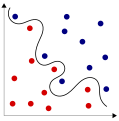Linear separability
Linear separability (also separability , or classifiability ) describes in mathematics the property of two relations ( sets of - tuples ) for which a hyperplane (or a linear discriminant function ) exists, which separates them in the -dimensional vector space .
In 2-dimensional space this means that a straight line can be laid between two linearly separable point sets.
Formal definition
Two subsets are called linearly separable if real numbers exist, so that for all the inequalities
be valid. The points from , for which applies, form the separating hyperplane.
Functions that can be linearly separated
Binary functions (i.e. with ) are called linearly separable if the archetypes of 0 and 1 are separable. The linearly separable functions play a role especially in machine learning . For example, the simple perceptron can only learn linearly separable functions.
An example of a function that cannot be linearly separated is the XOR link . As the diagram shows, a linear separation of the two result values is not possible.
See also
The linear separability of disjoint convex sets , which is plausible in the 2- or 3-dimensional visual space, is treated in the separation theorem . This also includes generalizations to infinite-dimensional spaces.
Separability as a property of filters in image processing should not be confused with linear separability.














